¶ Introduction
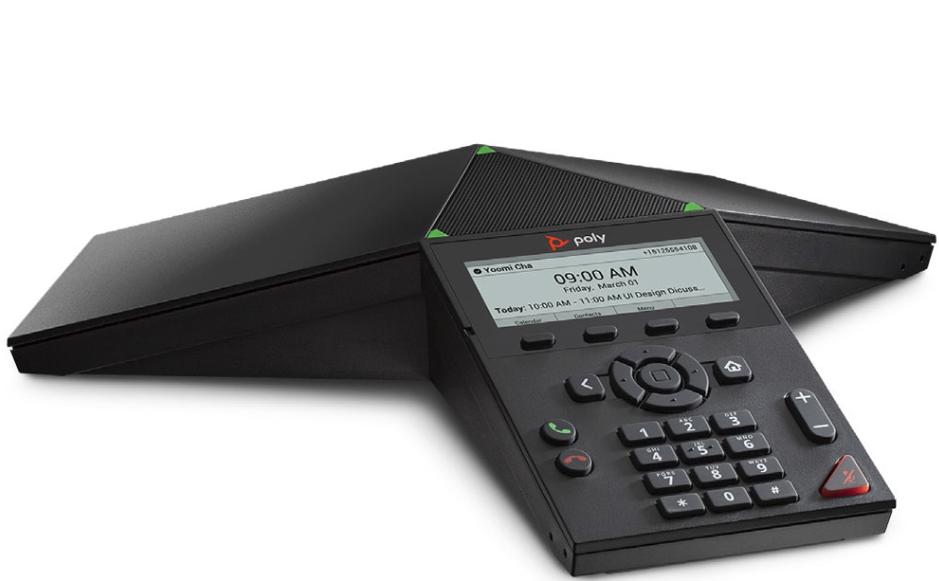
This Configuration Guide is written as a general guide on how to configure the Poly 8300 Conference phone to work with PBXware 5.3.10.
¶ Requirements
¶ Identifying Phone Model
To start and successfully complete the registration of your Polycom phone you need to know which phone model to set up.
On the back of each Polycom phone, there is model information that you should check. Although various phone models can have exactly the same requirements and installation procedures, phone models can also have significantly different requirements and installation procedures, so that is why it is important to know the model you own which results in you setting up the device successfully.
¶ Phone Firmware
- Make sure that your phone is loaded with an appropriate firmware version, 7.0.0.4265.
In order to check the firmware version:
- Press Home.
- Go to Settings and press Select.
- Go to Status and press Select.
- Go to Platform and press Select.
- Go to Application and press Select.
- Go to Main and press Select.
The firmware version is displayed under Version.
¶ DHCP Server
Fully configured and operational DHCP server.
¶ PBXware Version
PBXware version 5.3.9
In order to find out the PBXware version:
- Log in to PBXware
- Navigate to Settings: About.
On the top of About page, you may see a code similar to this one PBXware Edition: Multi-Tenant Release: 5.3.9.0 (41a4f0e6) Running: 13.23.1-gc-2e09fa3d, Proxy v5.3.9 (231c5f3), API: 5.3, libmemcached version: 1.0.18, where Release denotes the current version of your PBXware.
¶ Installation
This section describes how to install and connect the phone to the electrical power and data network as well as how to apply factory settings.
The following topics are covered:
- Power Adapter
- Power over Ethernet (PoE)
- Factory Settings
¶ Power Adapter
Connect the Network and Power
- Connect the DC plug on the power adapter to the DC port on the phone and connect the other end of the power adapter into an electrical power outlet.
- Connect the Ethernet cable between the Internet port on the phone and the network port on a router or switch to access LAN.
NOTE: If you are using Power over Ethernet (PoE), you don't need to connect the AC adapter. Make sure that the Ethernet cable and router or switch is Power over Ethernet (PoE) compliant.
¶ Power over Ethernet (PoE)
Connect the Network (only)
Using a regular Ethernet cable, your phone can be powered from a Power over Ethernet (PoE) compliant router or switch.
- Connect the Ethernet cable between the Internet port on the phone and an available port on the in-line power router or switch.
NOTE: If you are using Power over Ethernet (PoE), you don't need to connect the AC adapter. Make sure that the Ethernet cable and router or switch is Power over Ethernet (PoE) compliant.
¶ Find the phone IP address
Find out your Polycom Trio phone's IP Address.
- Press Home.
- Go to Settings and press Select.
- Go to Status and press Select.
- Go to Platform and press Select.
- Go to Phone and press Select.
The IP address will be displayed on the top of the display.
¶ Reset to Factory Settings
This step is not required for out-of-the-box phones, however, if the phone has been already used, then it is a must.
- Press Home and press Select.
- Go to Settings and press Select.
- Go to Advanced and press Select.
- Enter the password (The default password is 456) and press Enter.
- Go to Administration Settings and press Select.
- Go to Reset to Defaults and press Select.
- Go to Reset To Factory and press Select.
- Wait some time for a device to reboot.
NOTE: Do not unplug or remove power from the phone while it is updating firmware and configuration..
¶ Registering Phone
This section describes how to identify the Polycom phone model, requirements that must be met, and how to register a phone using Manual configuration or Auto provisioning.
The following topics are covered:
- Manual Configuration
- Auto Provisioning
¶ Manual Configuration
This section describes how to set UAD settings, create the PBXware Extension, and register the phone.
The following topics are covered:
- UAD Settings
- Creating an Extension
- Registering a Phone
¶ UAD Settings
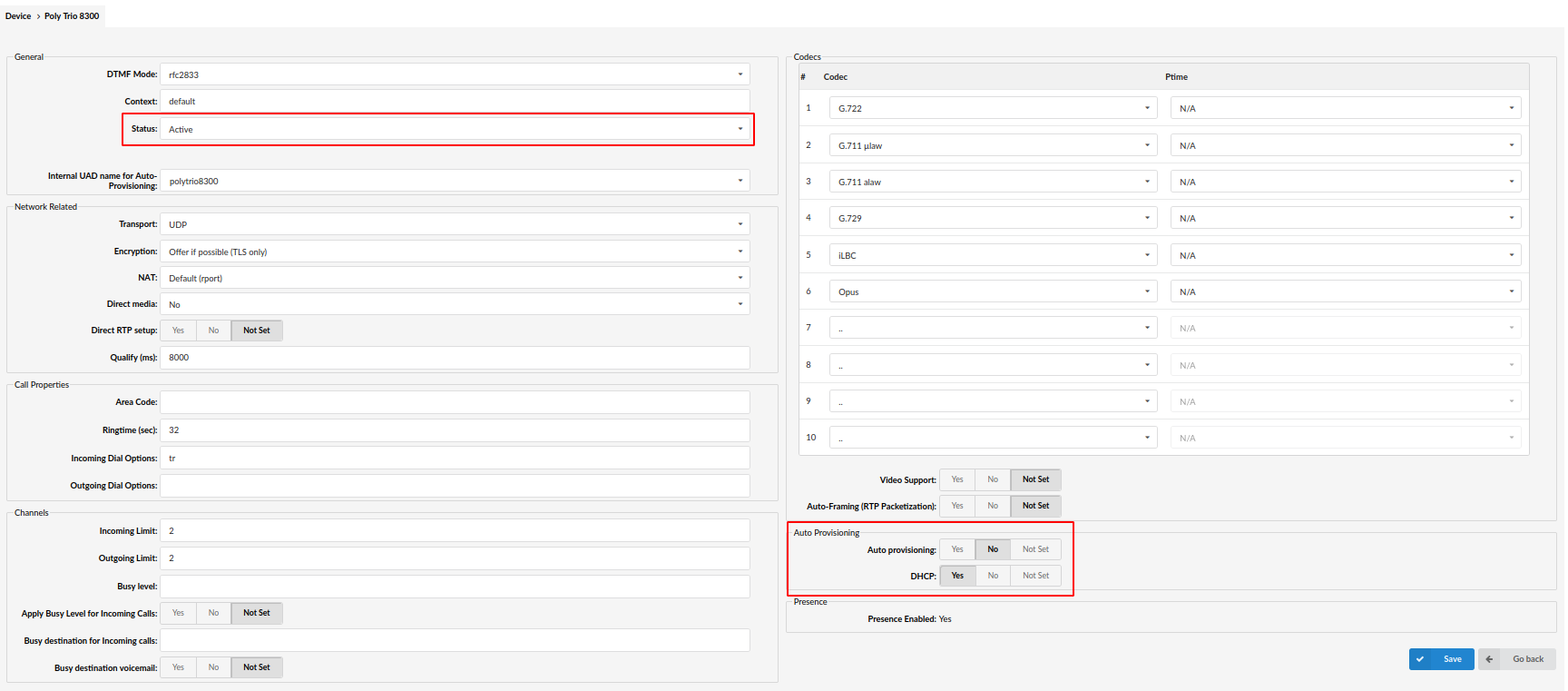
Log in to the PBXware's web administration interface
- Open a new browser window and enter the IP address in order to access the PBXware web administration login screen. Example: http://192.168.1.10.
- Log in to PBXware with your e-mail address and password.
UAD Settings
- Navigate to Settings: UAD.
- Make sure that the Polycom UAD is enabled. To check the UAD status, click the Edit icon corresponding to your Polycom phone.
- Make sure that Status is set to Active, Auto provisioning is set to No, and DHCP is set to Yes.
- Click the Save button to save changes.
¶ Creating an Extension
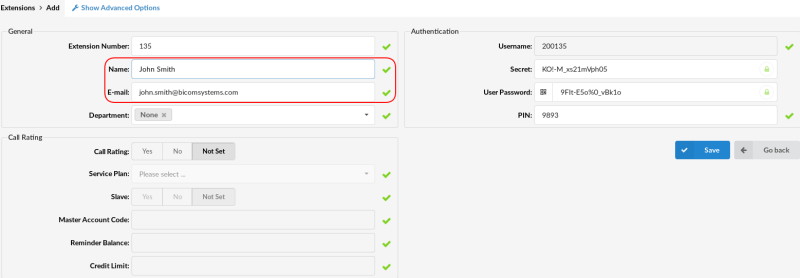
Add the Extension
- Navigate to Extensions. Click the Add Extension button.
- The standard options window will be shown below.
- Select the Polycom phone model from the UAD select box.
- Select Location: Local or Remote.
Local is for all Extensions registered on the LAN and Remote is for all Extensions registered from remote networks, WAN, Internet etc.
- Click the Next step button.
Extension Values
Enter values into the required field text boxes.
REQUIRED FIELDS:
- Name
Enter a name for the Extension being created. Example: John Smith.
Enter the e-mail address associated with this Extension. This e-mail address will receive all system notification messages. Example: john.smith@bicomsystems.com
- Department
Define the Department to which the Extension belongs to. Example: Sales.
- Click the Save button.
¶ Registering a Phone
This section describes how to register a Polycom phone using Hostname or IP Address or DNS SRV.
The following topics are covered:
- Hostname or IP Address
¶ Registering a Device
Line configuration from the device's web interface
To access the web interface of the Polycom phone, users must know its IP address.
To find the IP address, please do the following:
- Press Home.
- Go to Settings and press Select.
- Go to Status and press Select.
- Go to Network and press Select.
- Go to TCP/IP Parameters and press Select.
The IP address will be displayed under IP.
Following this, please enter the phone's IP address into a web browser. If everything is done successfully, a message saying Password prompt should be displayed.
If the device uses the factory defaults, the password should be 456.
NOTE: Please note that depending on the Polycom device and its firmware, the web interface settings may vary.
- After a successful login, select Simple Setup.
- Navigate to the SIP Server group.
- Enter the PBXware's IP address into the Address field.
- Enter 5060 into the Port field.
- Navigate to IP Line Identification.
- Enter the Extension into the Address field.
- Enter the Extension into the Authentication User ID field.
- Enter the Extension Secret into the Authentication Password field.
- Press Save.
The phone should register after a couple of seconds. If not, please reboot the phone.
B) Line configuration on the device
- Press Home on the phone.
- Go to Settings and press Select.
- Go to Advanced and press Select.
- Enter password and press Enter. Please note that the factory default password is 456.
- Press Select to enter Administration Settings.
- Go to Line Configuration and press Select.
- Go to Line 1 and press Select.
- Go to Address and press the Edit button.
- Enter the PBXware's Extension number and press OK. Example: 1003.
- Go to Authentication and press Select.
- Go to User ID: and press the Edit button.
- Enter the PBXware's Extension number and press OK.
- Go to Password and press the Edit button.
- Enter the PBXware's Extension Secret and press OK. (E.g. %3DfChBz59)
- Press Back three times.
- Press Select for Save Config.
- Press Home on the phone.
- Go to Settings and press Select.
- Go to Advanced and press Select.
- Enter password and press Enter. Please note that the factory default password is 456.
- Press Select to enter Administration Settings.
- Go to Call Server Configuration and press Select.
- Press Select to enter SIP.
- Press Select to enter Server 1.
- Press Edit to edit Address.
- Enter the PBXware's IP address and press OK. (E.g. 192.168.8.185)
- Press the Back button three times.
- Press Select for Save Config.
- If everything is done as described above, you should have successfully registered your phone to PBXware.
Dial *123 to verify registration.
¶ Auto Provisioning
This section describes how to set UAD settings, create the PBXware Extension, and register the phone using DHCP or Static IP address.
The following topics are covered:
- UAD Settings
- Creating an Extension
- Registering a Phone
¶ UAD Settings
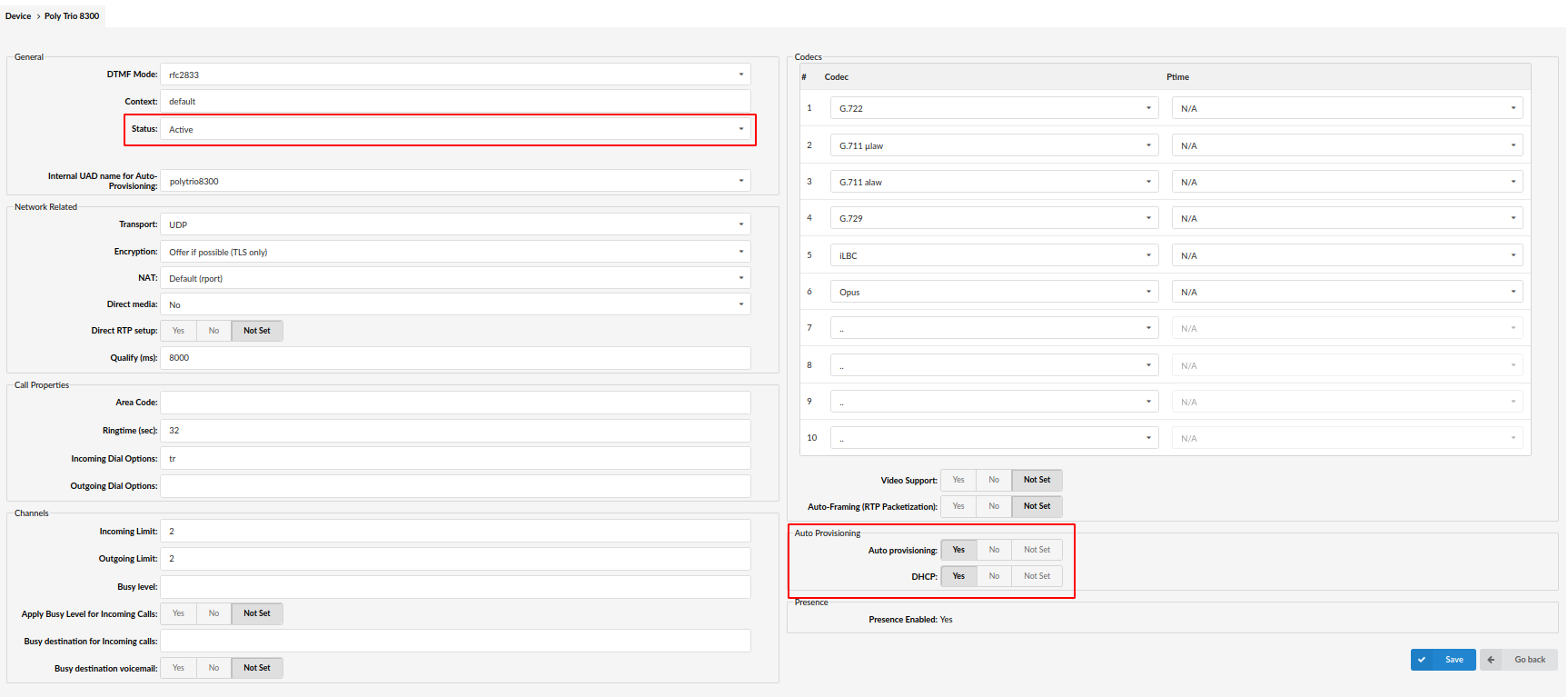
Log in to the PBXware's web administration interface.
- Open a new browser window and enter the IP address in order to access the PBXware web administration login screen. Example: http://192.168.1.10.
- Log in to PBXware with your e-mail address and password.
UAD Settings
- Navigate to Settings: UAD.
- Make sure that the Polycom UAD is enabled. To check the UAD status, click the Edit icon corresponding to your Polycom phone.
- Make sure that Status is set to Active, Auto provisioning is set to Yes, and DHCP is set to Yes.
- Click the Save button to save changes.
¶ Creating an Extension
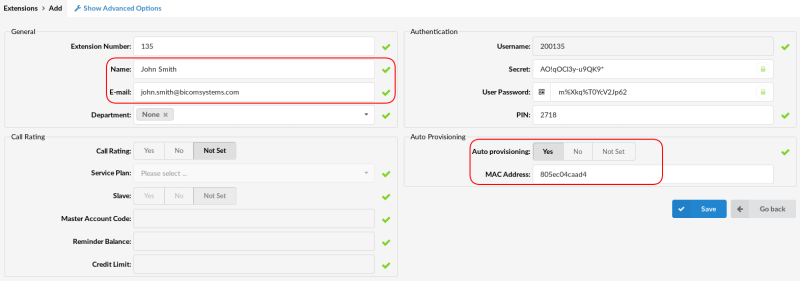
Add the Extension
- Navigate to Extensions. Click the Add Extension button.
- The standard options window will be shown below.
- Select the Polycom phone model from the UAD select box.
- Select Location: Local or Remote.
Local is for all Extensions registered on the LAN and Remote is for all Extensions registered from remote networks, WAN, Internet etc.
- Click the Next step button.
Extension values
Enter values into the required field text boxes.
REQUIRED FIELDS:
- Name
Enter a name for the extension being created. Example: John Smith.
Enter the e-mail address associated with this extension. This e-mail address will receive all system notification messages. Example: john.smith@bicomsystems.com
- Auto Provisioning
Set to Yes.
- MAC Address
Enter Polycom phone MAC address. Example: 001565FF1536. MAC address can be found at the back of the phone.
- Click on the Save button.
¶ Registering a Phone
This section describes how to register a Polycom phone using DHCP, TFTP, HTTP & HTTPS or DNS SRV.
The following topics are covered:
- DHCP
- TFTP or HTTP & HTTPS
- DNS SRV
¶ DHCP
Configure DHCP
- Make sure that thr DHCP router is configured to use option 66 to automatically instruct phones with the URL for auto-provisioning. For more information, please see the router documentation or contact a network administrator.
Phone's first boot or user-initiated reboot
- The auto-provisioning process will start during the phone's first boot or after the reboot process has been initiated by the user. Thr DHCP server will instruct the phone from where to pick up an appropriate configuration file. If everything is done as described above, you should have successfully registered the phone to PBXware.
Dial *123 to verify registration.
¶ TFTP or HTTP & HTTPS
Network Configuration
- Open a new browser window and enter the phone's IP address. (E.g. https://192.168.1.22)
- Enter password and press Submit. NOTE: The factory default password is: 456.
- Click the Settings tab.
- Click the Provisioning Server link under the Settings tab .
- Choose what server type you intend to use: HTTP, HTTPS or Trivial FTP. NOTE: Our recommendation is to use HTTP.
If you choose to use server type HTTP or HTTPS enter http:// or https:// followed by Hostname or IP Address then followed by /prov.
Example of a Hostname using HTTP: http://abc.bicomsystems.com/prov
Example of a Hostname using HTTPS: https://abc.bicomsystems.com/prov
Example of an IP Address using HTTP: http://192.168.1.10/prov
Example of an IP Address using HTTPS: https://192.168.1.10/prov
- Enter Auto Provisioning username and password into User Name and Password fields.
If the Server Type is TFTP, enter Hostname or IP Address.
Example of a Hostname: tftp://voip.bicomsystems.com
Example of an IP Address: tftp://192.168.1.10
- Click Save and confirm by pressing Yes.
Wait some time for a device to reboot.
The auto-provisioning process will start during the phone's reboot process. The phone will pick up an appropriate configuration file from PBXware. If everything is done as described above, you should have successfully registered your phone to PBXware.
Dial *123 to verify registration.
¶ DNS SRV
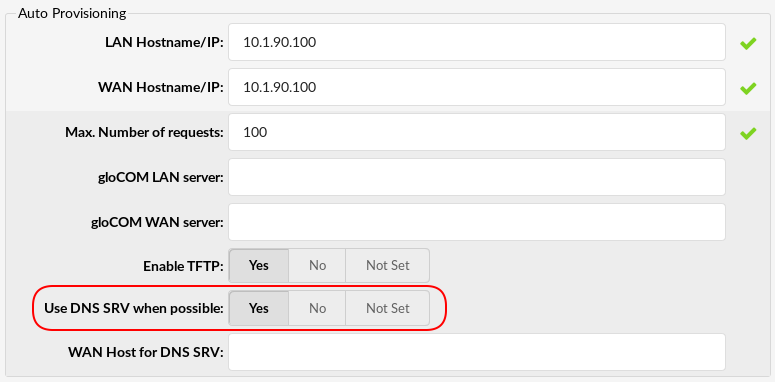
This section describes how to use a DNS SRV record which specifies the location of PBXware.
NOTE: The DNS Server needs to be configured correctly for this to work. Bicom Systems can provide a service to set this up for you.
Check if the DNS SRV is enabled in PBXware
- Contact a PBXware administrator to find out if the DNS SRV is enabled in PBXware. In case you have access to PBXware, you can check this yourself.
- Open a new browser window and enter the IP address in order to access the PBXware's web administration login screen. Example: http://192.168.1.10.
- Log in to PBXware with the e-mail address and password
- Navigate to Settings: Servers and click Edit.
- In Auto Provisioning group, make sure Use DNS SRV when possible: is set to Yes. If it is set to No or N/A, set to Yes and click Save.
NOTE: User have to re-save all their Extensions configured for Auto Provisioning.
Configure Line
- Press Menu on the phone.
- Scroll to Settings and press Select.
- Scroll to Advanced and press Select.
- Enter password and press Enter. Please note that the factory default password is 456.
- Press Select to enter Admin Settings.
- Go to Line Configuration and press Select.
- Go to Line 1 and press Select.
- Go to Server 1 and press Select.
- Press Edit to edit the Address line.
- Enter the Hostname. (Example of a Hostname: abc.bicomsystems.com) Please make sure to replace the Hostname from this example with your PBXware's Hostname.
- Make sure that the DNS server is configured to automatically route a registration request to PBXware which is actually under another domain name, for example: abc.bicomsystems.com.
- Go to Authentication and press Select.
- Press Edit to edit User ID.
- Enter the PBXware's Extension number and press OK. Example: 1003.
- Go to Password and press Edit.
- Enter Extension Secret as received in the e-mail associated with this Extension and press OK. Example: %3DfChBz59.
- Press Back twice, then press Select to Save Configuration.
- The auto provisioning process will start during the phone's reboot process. the phone will pick up an appropriate configuration file from PBXware. If everything is done as described above, you should have successfully registered the phone to PBXware.
Dial *123 to verify registration.